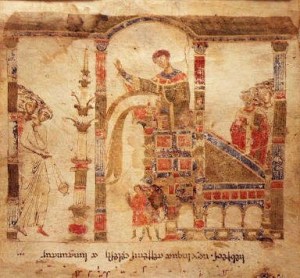Exsultet! Proclaiming the good news of Christ in the Easter Song of Praise

A few weeks ago, I represented the Anglican church at an ecumenical service commemorating the Bombardment in the Hague in 1945 by British forces, a tragic mistake which cost many lives. Part of the collateral damage included the loss of the former English & American church. After the service, my Roman Catholic and Protestant colleagues told me they will be holding an Easter Vigil in their churches on Easter Saturday. In the liturgy, the deacon proclaims Christ as the light of the world, fulfilling the bishop’s ordination charge as herald of the good news. This is both a diaconal and an ecumenical moment in the life of the Church.
In this short article, I’d like to look at why this is an important moment for deacons (and the church) in the shape of the liturgy, before exploring some options for including the Exsultet in your service this Easter.
Why the deacon?
Deacon Bill Ditewig writes:
The deacon is entrusted with the great sign of the risen Christ: the Easter Candle, as the minister most often associated with Christ in early Christian literature. After the lighting of the candle by the President, the deacon leads the assembly into the darkened church, stopping at the entrance to the church to proclaim, “Christ, our Light”, at which point people begin to light their own individual candles (representing the candle received at baptism). The deacon continues to the middle of the church, stops and again intones, “Christ, our Light”, as the process of candle-lighting continues. Finally, for the third and last time, the deacon reaches the front of the church and intones “Christ, our Light”. The deacon places the Candle in its stand and awaits the arrival in the sanctuary of the presider and other ministers. The deacon requests and receives a blessing from the presider, and then moves back to the Candle, where he intones the Exsultet.
Christ, Cross, Candle, and Gospel: An Early Lenten Reflection on the Deacon and the Exsultet. Deacons Today: Servants in a Servant Church (billditewig.blog)
The Exsultet
Depending on your context, you may or may not be able to celebrate the Easter Vigil on Saturday in Holy Week. However, the Church of England volume Times & Seasons provides for the Exsultet (Easter Song of Praise) in its outline for a ‘mid-morning Eucharist on Easter Day using Elements from the Easter Liturgy’.
Michael Perham & Kenneth Stevenson describe how the people light their individual candles either directly from it, or, when numbers are great, by light passed from one to another, until the whole church is a mass of candle light.
At three points during the procession the paschal candle bearer says or sing ‘The light of Christ with the people’s response ‘Thanks be to God’. The tradition, when it is sung, is that it goes up a tone each time. When the procession reaches the candle stand, situated in a prominent and visible place (e.g. lectern, pulpit, or altar) the candle is placed on its stand and the words ‘Alleluiah, Christ is risen’ are followed by the response ‘He is risen indeed. Alleluiah’. This can be repeated three times with an increase of volume each time, so that it begins with a whisper and ends with a shout! This is the congregation’s first opportunity to respond to what is being proclaimed. The third exchange might lead into a fanfare on trumpet or organ. The Exsultet follows.
Waiting for the Risen Christ: A Commentary on Lent, Holy Week, Easter: Services and Prayers (SPCK, 1986), 108-109
Times & Seasons suggest that if possible, the Deacon sings the Introduction:
Rejoice, heavenly powers! Sing, choirs of angels!
O Universe, dance around God’s throne!
Jesus Christ, our King, is risen!
Sound the victorious trumpet of salvation!
Rejoice, O earth, in glory, revealing the splendour of your creation,
radiant in the brightness of your triumphant King!
Christ has conquered! Now his life and glory fill you!
Darkness vanishes for ever!
Rejoice, O Mother Church! Exult in glory!
The risen Saviour, our Lord of life, shines upon you!
Let all God’s people sing and shout for joy.
Another option is for the whole congregation to sing the following text to WOODLANDS (Tell out, my soul)
Sing, choirs of heaven! Let saints and angels sing!
Around God’s throne exult in harmony!
Now Jesus Christ is risen from the grave!
Salute your King in glorious symphony!
Sing, choirs of earth! Behold, your light has come!
The glory of the Lord shines radiantly!
Lift up your hearts, for Christ has conquered death!
The night is past, the day of life is here!
Sing, Church of God! Exult with joy outpoured!
The gospel trumpets tell of victory won!
Your Saviour lives; he’s with you evermore!
Let all God’s people sound the long Amen!
Alternatively, if the Deacon prefers to give a spoken presentation, this can be made more effective in one of two ways:
- Making it a quieter element between two great musical bursts of praise: a fanfare on organ and a vibrant sung Gloria immediately after.
- Making it more congregational, with some verses printed for all to say, so that it takes on a more responsorial character.
But whichever version you prefer, the important thing is that deacons should everywhere continue to proclaim Christ, the light of the world!
Jonathan Halliwell (deacon@stjohn-stphilip.org)
Note: I will be singing the Introduction suggested above on Easter day to a simplified version of the ancient and beautiful chant. Feel free to contact me for a copy of the chant or for further advice.
The illustration is the Deacon Singing the Exultet from Exultet Roll
In this scene he gestures toward the Paschal Candle,
which is being incensed
Italian (Montecassino), ca. 1072
